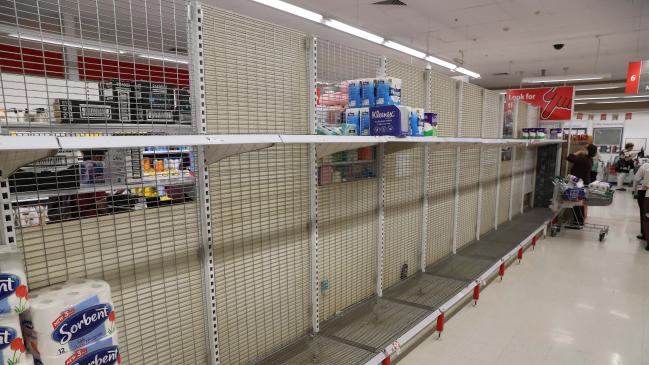
This article is more than
6 year old
Coronavirus panic has gripped Australia, with supermarket shelves across the country stripped of non-perishable food, hand sanitiser and toilet paper.
The number of confirmed cases here of the potentially deadly virus rose again today and the government has warned that disruptions to everyday life will occur, as public health authorities battle to contain the spread.
Teams of researchers around the world are scrambling to find a vaccine for coronavirus, which has infected more than 93,000 people and claimed 3198 lives across almost 70 countries.
When is the crisis likely to end?
Dr Sanjaya Senanayake is an infectious diseases physician and an associate professor at the Australian National University medical school, and said it could take the global deployment of a vaccine to contain the outbreak.
“That could be the case,” Dr Senanayake told news.com.au. “Once we get a viable vaccine up and running, if we can get that deployed, it should terminate the outbreak.”
But experts have warned that could be at least 12 to 18 months away, meaning the past few months is just the start of things to come.
The good news is that medical science is “better than ever before” at producing vaccines, Dr Senanayake said.
Whereas it once could’ve taken three to five years to get a viable vaccine up and running, experts are hopeful of developing a drug to tackle coronavirus in a much shorter time frame.
“To get it ready for testing and then having it deployable widely around the world in 10 or 12 months is quite amazing,” he said. “But of course that doesn’t help us right now.”
One possible scenario that could ease the crisis is, ironically, the further spread of coronavirus, Dr Senanayake said.
“If we get a rapid rate of infection and a lot of people around the world become infected, they might be able to provide herd immunity to uninfected people and transmission could stop.
“That’s one possibility. Whether that takes a few months or many months is uncertain.”
RELATED: How serious coronavirus outbreak would change your everyday life
RELATED: New data shows how coronavirus compares with influenza


Looking at other significant disease outbreaks in recent history and how they were interrupted highlights the need for international co-operation.
But it’s not necessarily a reliable indicator of what’s likely to happen next with coronavirus, Dr Senanayake said.
“Coronavirus has an almost 80 per cent genetic similarity to SARS but it’s acted quite differently, in the sense that it seems to be much more infectious.”
The outbreak of SARS in 2003 plunged the world into uncertainty and impacted financial markets, air travel and health systems. The respiratory illness spread to 26 countries and infected more than 8000 people, killing an estimated 774.
“SARS took eight months to infect 8000 people and then it suddenly disappeared,” Dr Senanayake said.
“In the space of 10 weeks or so, we’ve had 90,000 people confirmed with infections. So, it’s clearly much more infectious.”
RELATED: Major Australian retailers limit toilet paper pack purchases per customer

Coronavirus is more comparable to the swine flu outbreak in 2009, in terms of its highly infectious nature and the fact that it was an illness not encountered before.
“The case fatality rate for swine flu though was 0.1 per cent and we think for COVID-19 it’s higher. How much higher, we’re not entirely sure yet,” Dr Senanayake said.
“In China, it’s thought to be the 2 to 3 per cent rate but a lot of people think there are cases that haven’t been diagnosed because they’re quite mild and so the case fatality rate could be lower.
“Having said that, it’s still degrees higher than swine flu and it could certainly cause some problems.”
Professor Brendan Murphy, Australia’s Chief Medical Officer, estimated that 80 per cent of people who contract coronavirus will experience only mild symptoms.
Most will “barely notice it”, Professor Murphy told a Senate Estimates hearing today, and that’s especially the case for children.
But the need for a robust emergency response from governments and public health authorities remains – and will for some time.
“While it’s clear this disease is going to be with us for a while, the focus at the moment is containment (and) to slow the spread and keep the situation under control,” he said.

It’s critical for countries like Australia to implement “really good infection control measures” to try to slow the spread of coronavirus, Dr Senanayake said.
And it could be just that thing that helps beat the disease.
“We got on top of SARS with good infection control measures because people were only infectious after they developed symptoms,” he said.
“The fact that it stopped suddenly and never appeared again after the 2003-2004 period is a mystery. I don’t know what it did and where it went. We didn’t see the odd case every couple of years. We just never saw it again.
“This is a new virus and we’re learning about its behaviour. It might just suddenly disappear – that’s not entirely unreasonable.
“Will it be a change in season – if it prefers the colder weather or warmer weather – or something else? Who knows. Regardless, we have to act as if we think it’s going to stick around in regards to our pandemic planning.”
RELATED: Countries where coronavirus has been confirmed
It’s likely – although not certain at this stage – that coronavirus will stick around after a vaccine is deployed and become “pandemic”.
After the infection peaks, with a declining number of cases and an easing of pressure on the health system, things will begin to return to normal.
The government’s emergency pandemic response plan, implemented last week and now in Phase Two – an active, flexible and powerful approach to containing the spread – would then move to Phase Three.
The focus in a Phase Three or Stand Down scenario would then be on managing the virus in the same way that health authorities do any other infectious illness.
“There are other coronaviruses and some of them prefer cooler weather, some prefer warmer weather and seasonal infection is certainly a possibility,” Dr Senanayake said
“We’ve seen that with swine flu. Ever since it arrived in 2009, it’s been reoccuring every flu season.”
There are many unknowns with coronavirus, given it’s a new challenge and poses a number of complexities, he conceded.
“That’s what’s scary about it. The public look to experts in infectious disease, public health, microbiology and etc, to give everyone a sense of certainty. But because it’s new, we can’t do that.
“Everything will become clearer with time, but how much time and what we’ll learn is hard to say. The situation is rapidly evolving.
“Two weeks ago, if you’d asked me whether we’d see cases popping up in Italy and South Korea having thousands of cases, I would’ve been surprised. Here we are.
“One public health expert a couple of weeks ago was asked to predict what was going to happen. He said that anyone who says they can predict what’s going to happen with this virus, they don’t know what they’re talking about.